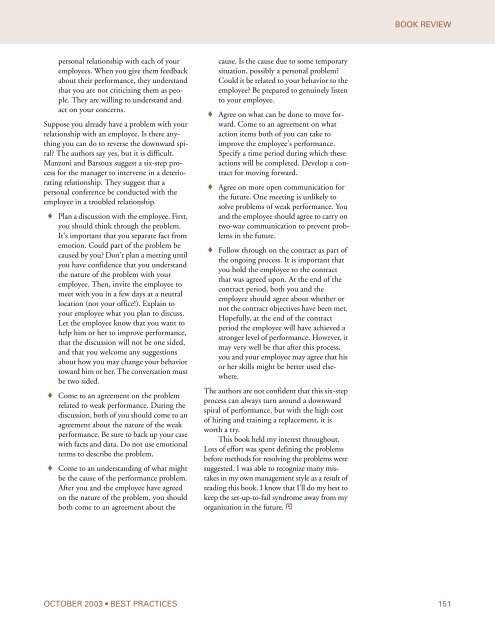October - Center for Information-Development Management
October - Center for Information-Development Management
October - Center for Information-Development Management
You also want an ePaper? Increase the reach of your titles
YUMPU automatically turns print PDFs into web optimized ePapers that Google loves.
BOOK REVIEWpersonal relationship with each of youremployees. When you give them feedbackabout their per<strong>for</strong>mance, they understandthat you are not criticizing them as people.They are willing to understand andact on your concerns.Suppose you already have a problem with yourrelationship with an employee. Is there anythingyou can do to reverse the downward spiral?The authors say yes, but it is difficult.Manzoni and Barsoux suggest a six-step process<strong>for</strong> the manager to intervene in a deterioratingrelationship. They suggest that apersonal conference be conducted with theemployee in a troubled relationship.♦ Plan a discussion with the employee. First,you should think through the problem.It's important that you separate fact fromemotion. Could part of the problem becaused by you? Don't plan a meeting untilyou have confidence that you understandthe nature of the problem with youremployee. Then, invite the employee tomeet with you in a few days at a neutrallocation (not your office!). Explain toyour employee what you plan to discuss.Let the employee know that you want tohelp him or her to improve per<strong>for</strong>mance,that the discussion will not be one sided,and that you welcome any suggestionsabout how you may change your behaviortoward him or her. The conversation mustbe two sided.♦ Come to an agreement on the problemrelated to weak per<strong>for</strong>mance. During thediscussion, both of you should come to anagreement about the nature of the weakper<strong>for</strong>mance. Be sure to back up your casewith facts and data. Do not use emotionalterms to describe the problem.♦ Come to an understanding of what mightbe the cause of the per<strong>for</strong>mance problem.After you and the employee have agreedon the nature of the problem, you shouldboth come to an agreement about thecause. Is the cause due to some temporarysituation, possibly a personal problem?Could it be related to your behavior to theemployee? Be prepared to genuinely listento your employee.♦ Agree on what can be done to move <strong>for</strong>ward.Come to an agreement on whataction items both of you can take toimprove the employee's per<strong>for</strong>mance.Specify a time period during which theseactions will be completed. Develop a contract<strong>for</strong> moving <strong>for</strong>ward.♦ Agree on more open communication <strong>for</strong>the future. One meeting is unlikely tosolve problems of weak per<strong>for</strong>mance. Youand the employee should agree to carry ontwo-way communication to prevent problemsin the future.♦ Follow through on the contract as part ofthe ongoing process. It is important thatyou hold the employee to the contractthat was agreed upon. At the end of thecontract period, both you and theemployee should agree about whether ornot the contract objectives have been met.Hopefully, at the end of the contractperiod the employee will have achieved astronger level of per<strong>for</strong>mance. However, itmay very well be that after this process,you and your employee may agree that hisor her skills might be better used elsewhere.The authors are not confident that this six-stepprocess can always turn around a downwardspiral of per<strong>for</strong>mance, but with the high costof hiring and training a replacement, it isworth a try.This book held my interest throughout.Lots of ef<strong>for</strong>t was spent defining the problemsbe<strong>for</strong>e methods <strong>for</strong> resolving the problems weresuggested. I was able to recognize many mistakesin my own management style as a result ofreading this book. I know that I'll do my best tokeep the set-up-to-fail syndrome away from myorganization in the future.OCTOBER 2003 • BEST PRACTICES 151





